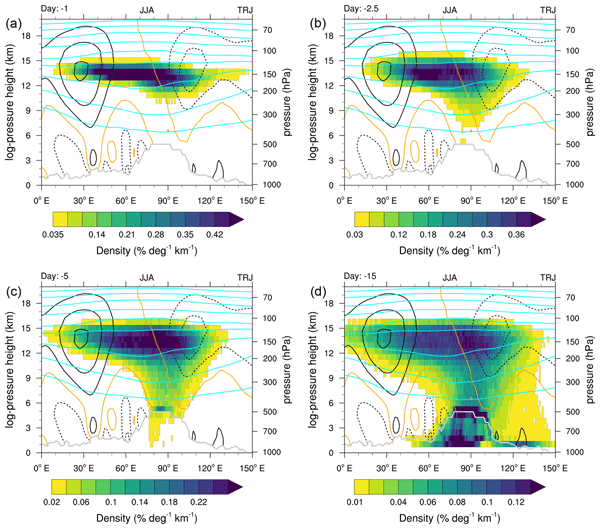New publication in Atmospheric Chemistry and Physics

A new study by Nützel et al. on the “Climatology and variability of air mass transport from the boundary layer to the Asian monsoon anticyclone” is published in the EGU open access journal “Atmospheric Chemistry and Physics”. The Asian monsoon anticyclone is studied by using backward trajectories on reanalysis data for 14 northern summer seasons. Furthermore, forward trajectories from a free- running chemistry-climate model (CCM) simulation with parameterised Lagranigan convection in the EMAC-ATTILA model are analysed.
https://doi.org/10.5194/acp-22-15659-2022
Abstract: Air masses within the Asian monsoon anticyclone (AMA) show anomalous signatures in various trace gases. In this study, we investigate how air masses are transported from the planetary boundary layer (PBL) to the AMA based on multiannual trajectory analyses. In particular, we focus on the climatological perspective and on the intraseasonal and interannual variability. Further, we also discuss the relation of the interannual east–west displacements of the AMA with the transport from the PBL to the AMA.
To this end we employ backward trajectories, which were computed for 14 northern summer (June–August) seasons using reanalysis data. Further, we backtrack forward trajectories from a free-running chemistry–climate model (CCM) simulation, which includes parametrized Lagrangian convection. The analysis of 30 monsoon seasons of this additional model data set helps us to carve out robust or sensitive features of transport from the PBL to the AMA with respect to the employed model.
Results from both the trajectory model and the Lagrangian CCM emphasize the robustness of the three-dimensional transport pathways from the top of the PBL to the AMA. Air masses are transported upwards on the south-eastern side of the AMA and subsequently recirculate within the full AMA domain, where they are lifted upwards on the eastern side and transported downwards on the western side of the AMA. The contributions of different PBL source regions to AMA air are robust across the two models for the Tibetan Plateau (TP; 17 % vs. 15 %) and the West Pacific (around 12 %). However, the contributions from the Indian subcontinent and Southeast Asia are considerably larger in the Lagrangian CCM data, which might indicate an important role of convective transport in PBL-to-AMA transport for these regions.
The analysis of both model data sets highlights the interannual and intraseasonal variability of the PBL source regions of the AMA. Although there are differences in the transport pathways, the interannual east–west displacement of the AMA – which we find to be related to the monsoon Hadley index – is not connected to considerable differences in the overall transport characteristics.
Our results from the trajectory model data reveal a strong intraseasonal signal in the transport from the PBL over the TP to the AMA: there is a weak contribution of TP air masses in early June (less than 4 % of the AMA air masses), whereas in August the contribution is considerable (roughly 24 %). The evolution of the contribution from the TP is consistent across the two modelling approaches and is related to the northward shift of the subtropical jet and the AMA during this period. This finding may help to reconcile previous results and further highlights the need of taking the subseasonal (and interannual) variability of the AMA and associated transport into account.
© Author(s) 2022. This work is distributed under the Creative Commons Attribution 4.0 License.
Nützel, M., Brinkop, S., Dameris, M., Garny, H., Jöckel, P., Pan, L. L., and Park, M.: Climatology and variability of air mass transport from the boundary layer to the Asian monsoon anticyclone, Atmos. Chem. Phys., 22, 15659–15683, https://doi.org/10.5194/acp-22-15659-2022, 2022.
